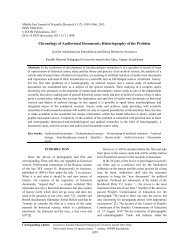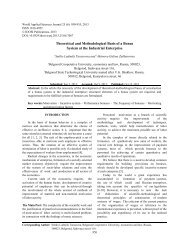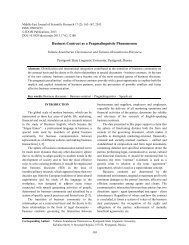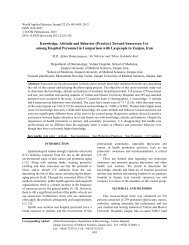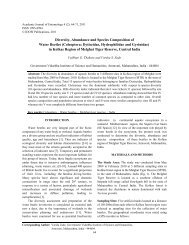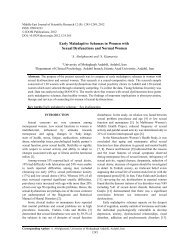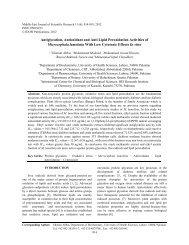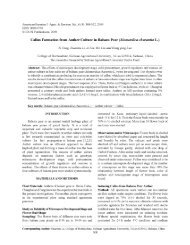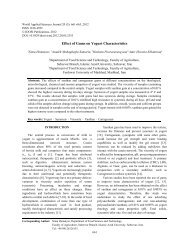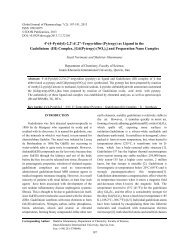Antimicrobial Activity of Some Important Medicinal Plant ... - Idosi.org
Antimicrobial Activity of Some Important Medicinal Plant ... - Idosi.org
Antimicrobial Activity of Some Important Medicinal Plant ... - Idosi.org
You also want an ePaper? Increase the reach of your titles
YUMPU automatically turns print PDFs into web optimized ePapers that Google loves.
World Journal <strong>of</strong> Agricultural Sciences 4 (S): 839-843, 2008<br />
ISSN 1817-3047<br />
© IDOSI Publications, 2008<br />
<strong>Antimicrobial</strong> <strong>Activity</strong> <strong>of</strong> <strong>Some</strong> <strong>Important</strong> <strong>Medicinal</strong><br />
<strong>Plant</strong> Against <strong>Plant</strong> and Human Pathogens<br />
1 2<br />
B. Mahesh and S. Satish<br />
1Department<br />
<strong>of</strong> Studies in Applied Botany and Biotechnology,<br />
University <strong>of</strong> Mysore, Manasagangotri, Mysore-570 006<br />
2Herbal<br />
Drug Technology Laboratory, Department <strong>of</strong> Studies in Microbiology,<br />
University <strong>of</strong> Mysore, Manasagangotri, Mysore-570 006<br />
Abstract: The methanol leaf extracts <strong>of</strong> Acacia nilotica, Sida cordifolia, Tinospora cordifolia,<br />
Withania somnifer and Ziziphus mauritiana showed significant antibacterial activity against Bacillus subtilis,<br />
Escherichia coli, Pseudomonas fluorescens, Staphylococcus aureus and Xanthomonas axonopodis pv.<br />
malvacearum and antifungal activity against Aspergillus flavus, Dreschlera turcica and Fusarium<br />
verticillioides when compare to root/ bark extracts. A. nilotica and S. cordifolia leaf extract showed highest<br />
antibacterial activity against B. subtilis. and Z. mauritiana leaf extract showed significant activity<br />
against X. a. pv. malvacearum. Root and leaf extract <strong>of</strong> S. cordifolia recorded significant activity against all<br />
the test bacteria. A. nilotica bark and leaf extract showed significant antifungal activity against A. flavus,<br />
Ziziphus mauritiana and Tinospora cordifolia recorded significant antifungal activity against D. turcica The<br />
methanol extract <strong>of</strong> Sida cordifolia exhibited significant antifungal activity against F. verticillioides.<br />
Key words: Antibacterial Antifungal <strong>Medicinal</strong> plants<br />
INTRODUCTION drugs from higher plants continue to occupy an important<br />
niche in modern medicine. On a global basis, atleast<br />
The use <strong>of</strong> medicinal plants as a source for relief from 130 drugs, all single chemical entities extracted from<br />
illness can be traced back over five millennia to written higher plants, or modified further synthetically, are<br />
documents <strong>of</strong> the early civilization in China, India and the currently in use, though some <strong>of</strong> them are now being<br />
Near east, but it is doubtless an art as old as made synthetically for economic reasons [5].<br />
mankind. Neanderthals living 60,000 years ago in present <strong>Medicinal</strong> plants represent a rich source <strong>of</strong><br />
day Iraq used plants such as hollyback, these plants are antimicrobial agents. <strong>Plant</strong>s are used medicinally in<br />
still widely used in ethnomedicine around the world different countries and are a source <strong>of</strong> many potent and<br />
[1,2]. powerful drugs [6]. A wide range <strong>of</strong> medicinal plant parts<br />
The potential <strong>of</strong> higher plants as source for new is used for extract as raw drugs and they possess varied<br />
drugs is still largely unexplored. Among the estimated medicinal properties. The different parts used include<br />
250,000-500,000 plant species, only a small percentage has root, stem, flower, fruit, twigs exudates and modified plant<br />
been investigated phytochemically and the fraction <strong>org</strong>ans. While some <strong>of</strong> these raw drugs are collected in<br />
submitted to biological or pharmacological screening is smaller quantities by the local communities and folk<br />
even smaller. Thus, any phytochemical investigation <strong>of</strong> a healers for local used, many other raw drugs are collected<br />
given plant will reveal only a very narrow spectrum <strong>of</strong> its in larger quantities and traded in the market as the raw<br />
constituents. Historically pharmacological screening <strong>of</strong> material for many herbal industries [7]. Although<br />
compounds <strong>of</strong> natural or synthetic origin has been the hundreds <strong>of</strong> plant species have been tested for<br />
source <strong>of</strong> innumerable therapeutic agents. Random antimicrobial properties, the vast majority <strong>of</strong> have not<br />
screening as tool in discovering new biologically active been adequately evaluated [8]. Considering the vast<br />
molecules has been most productive in the area <strong>of</strong> potentiality <strong>of</strong> plants as sources for antimicrobial drugs<br />
antibiotics [3,4]. Even now, contrary to common belief, with reference to antibacterial and antifungal agents, a<br />
Corresponding Author: S. Satish, Herbal Drug Technology Laboratory, Department <strong>of</strong> Studies in Microbiology,<br />
University <strong>of</strong> Mysore, Manasagangotri, Mysore- 570 006<br />
839
World J. Agric. Sci., 4 (S): 839-843, 2008<br />
systematic investigation was undertaken to screen the the thimble and extracted successively with methanol<br />
local flora for antibacterial and antifungal activity from solvent in Soxhlet extractor for 48h. The solvent extracts<br />
Acacia nilotica, Sida cordifolia, Tinospora cordifolia, were concentrated under reduced pressure and preserved<br />
Ziziphus mauritiana and Withania somnifera. The at 5°C in airtight bottle until further use.<br />
Acacia nilotica (L.) Willd. belongs to the family<br />
Mimosaceae. Decoction <strong>of</strong> bark is used as gargle and <strong>of</strong> Growth and Maintenance <strong>of</strong> Test Micro<strong>org</strong>anism for<br />
pods in urino-genital diseases. Sida cordifolia L. <strong>Antimicrobial</strong> Studies: Bacterial cultures <strong>of</strong><br />
(Malvaceae) root is used in pain, nervous disorders, Bacillus subtilis (B. subtilis), Escherichia coli (E. coli),<br />
coryza, cardiac diseases. The stem <strong>of</strong> Tinospora Pseudomonas fluorescens (P. fluorescens),<br />
cordifolia (Wild.) Hk.f. & Th. which belongs to the family Staphylococcus aureus (S. aureus) and Xanthomonas<br />
Menispermaceae is used as an ingredient for Ayurvedic axonopodis pv. malvacearum (X. axonopodis pv.<br />
preparations used in general debility, dyspepsia, fevers malvacearum) and fungal cultures <strong>of</strong> Aspergillus flavus<br />
and urinary diseases. Root is a powerful emetic and used (A. flavus), Dreschlera turcica (D. turcica) and<br />
for visceral obstruction; its watery extracts is used in Fusarium verticillioides (F. verticillioides), were<br />
leprosy. Withania somnifera (L.) Dunal which belong to obtained from the culture collection centre, Department <strong>of</strong><br />
the family Solanaceae is used in hiccup, cough, dropsy, Applied Botany and Biotechnology, University <strong>of</strong><br />
rheumatism and gynaecological disorders an as a sedative Mysore, India, were used for antimicrobial test <strong>org</strong>anisms.<br />
in senile debility. It is also useful in inflammatory The bacteria were maintained on nutrient broth (NB) at<br />
conditions, ulcers and scabies as external application. 37°C and fungus were maintained on Potato dextrose agar<br />
Leaves used as a febrifuge and applied to lesions painful<br />
swellings and sore eyes. Ziziphus mauritiana Lam.<br />
(PDA) at 28°C.<br />
Belongs to the family Rhamnaceae. The fruits used Preparation <strong>of</strong> Inoculum: The gram positive<br />
anodyne and tonic. They form one <strong>of</strong> the ingredients <strong>of</strong> (Bacillus subtilis and Staphylococcus aureus) and gram<br />
Joshanda, a medicine used in chest troubles. Kernels negative bacteria (Escherichia coli, Pseudomonas<br />
sedative, used as soporific and to stop vomiting; also fluorescens and Xanthomonas axonopodis pv.<br />
employed as an antidote to aconite-poisoning and in malvacearum) were pre-cultured in nutrient broth<br />
abdominal pains. Seeds are given in diarrhea. Leaves with overnight in a rotary shaker at 37°C, centrifuged at 10,000<br />
catechu (Areca catechu) used as an astringent and rpm for 5 min, pellet was suspended in double distilled<br />
considered diaphoretic. [9]. water and the cell density was standardized<br />
MATERIALS AND METHODS<br />
spectrophotometrically (A 610 nm). The fungal inoculum<br />
(F. verticillioides, D. turcica and A. flavus) was<br />
prepared from 5 to 10 day old culture grown on Potato<br />
Collection <strong>of</strong> <strong>Plant</strong> Material: Fresh leaves bark and root dextrose agar medium. The Petri dishes were flooded with<br />
<strong>of</strong> five different plants viz., Acacia nilotica(L.) Willd., 8 to 10 ml <strong>of</strong> distilled water and the conidia were scraped<br />
Sida cordifolia L., Tinospora cordifolia (Wild.) using sterile spatula. The spore density <strong>of</strong> each fungus<br />
Hk.f. & Th., Withania somnifera (L.) Dunal and was adjusted with spectrophotometer (A595 nm) to<br />
Ziziphus mauritian Lam. free from disease were collected<br />
5<br />
obtain a final concentration <strong>of</strong> approximately 10<br />
from Mysore and Nanjangud, Karnataka. The leaves were<br />
washed thoroughly 2-3 times with running water and once<br />
spores/ml.<br />
with sterile distilled water, leaf, bark and root material was Anti-bacterial <strong>Activity</strong>: The methanol leaf extracts <strong>of</strong><br />
then air-dried on sterile blotter under shade. Acacia nilotica, Sida cordifolia Tinospora cordifolia,<br />
Withania somnifera and Ziziphus mauritian, bark extract<br />
Solvent Extraction: Thoroughly washed dried leaves <strong>of</strong> <strong>of</strong> Acacia nilotica Tinospora cordifolia and Ziziphus<br />
five plants <strong>of</strong> Acacia nilotica, Sida cordifolia Tinospora mauritian and root extract <strong>of</strong> Sida cordifolia and<br />
cordifolia, Withania somnifera and Ziziphus mauritian, Withania somnifera were tested by the disc diffusion<br />
bark extract <strong>of</strong> Acacia nilotica Tinospora cordifolia and method [10]. Different concentration <strong>of</strong> the extracts<br />
Ziziphus mauritian and root extract <strong>of</strong> Sida cordifolia (100 µg ml<br />
1<br />
) was prepared by reconstituting with<br />
and Withania somnifera <strong>of</strong> plant material were dried in methanol. The test micro<strong>org</strong>anisms were seeded into<br />
shade for five days and then powdered with the help <strong>of</strong> respective medium by spread plate method 10 µl<br />
Waring blender. 25 g <strong>of</strong> shade-dried powder was filled in<br />
6<br />
(10 cells/ml) with the 24h cultures <strong>of</strong> bacteria growth in<br />
840
World J. Agric. Sci., 4 (S): 839-843, 2008<br />
nutrient broth. After solidification the filter paper discs<br />
(5 mm in diameter) impregnated with the extracts were<br />
RESULTS<br />
placed on test <strong>org</strong>anism-seeded plates. B. subtilis, E. coli, Results obtained in the present study relieved that<br />
P. fluorescens S. aureus and X. a. pv. malvacearum the tested five medicinal plants extracts posses<br />
were used for antibacterial test. Streptomycin sulphate potential antibacterial activity against B. subtilis, E. coli,<br />
(10 µg ml<br />
1<br />
) used as positive control and methanol X. axonopodis pv. malvacearum, S. aureus,<br />
solvent (100 µg ml<br />
1<br />
) used as negative control The P. fluorescens, (Table 1) and antifungal activity against<br />
antibacterial assay plates were incubated at 37°C for 24h. F. verticillioides, D. turcica and A. flavus (Table 2).<br />
The diameters <strong>of</strong> the inhibition zones were measured in When tested by the disc diffusion method, the methanol<br />
mm. leaf extracts <strong>of</strong> Acacia nilotica showed significant<br />
activity against E. coli, S. aureus and X. a. pv.<br />
Antifungal <strong>Activity</strong>: The antifungal activity was tested by malvacearum around 15 mm. The highest antibacterial<br />
disc diffusion method [11]. The potato dextrose agar activity <strong>of</strong> 20 mm in B. subtilis and least activity recorded<br />
plates were inoculated with each fungal culture (10 days in E. coli measured 14 mm. Bark extract <strong>of</strong> Acacia nilotica<br />
old) by point inoculation. The filter paper discs (5 mm in exhibit highest activity against B. subtilis and S. aureus<br />
diameter) impregnated with 100 µg ml<br />
1<br />
concentrations <strong>of</strong> (15 mm) and lowest in P. fluorescens. Sida cordifolia leaf<br />
the extracts were placed on test <strong>org</strong>anism-seeded plates. extract posses maximum activity against B. subtilis and<br />
Methanol was used to dissolve the extract and was S. aureus (18 mm) and the 16 mm similar zone <strong>of</strong> inhibition<br />
completely evaporated before application on test observed in E. coli, P. fluorescens and X. a. pv.<br />
<strong>org</strong>anism-seeded plates. Blank disc impregnated with malvacearum. Root extract <strong>of</strong> this plant showed highest<br />
solvent methanol followed by drying <strong>of</strong>f was used as inhibitory activity against B. subtilis and S. aureus and<br />
negative control and Nystatin (10 µg disc<br />
1<br />
) used as least activity observed in E. coli. Tinospora cordifolia<br />
positive control. The activity was determined after 72 h <strong>of</strong> leaf extracts showed almost similar zone <strong>of</strong> inhibition<br />
incubation at 28°C. The diameters <strong>of</strong> the inhibition zones against all the tested bacteria except X. a. pv.<br />
were measured in mm. malvacearum, which showed highest activity (17 mm).<br />
Table 1: 1 1<br />
Antibacterial activity <strong>of</strong> some medicinal plant methanol extracts (100 µg ml ) and antibiotic (10 µg ml ) against bacterial species tested by disc<br />
diffusion assay<br />
Zone <strong>of</strong> inhibition (mm)<br />
------------------------------------------------------------------------------------------------------------------------------------<br />
Acacia nilotica Sida cordifolia Tinospora cordifolia Withania somnifera Ziziphus mauritiana<br />
------------------------- ----------------------- -------------------------- ------------------------- ------------------------- Streptomycin<br />
Bacterial sp. Bark Leaves Root Leaves Bark Leaves Root Leaves Bark Leaves sulphate<br />
Bacillus subtilis 15±0.66 20±1.20 16±0.33 18±0.57 13±0.79 15±0.51 14±0.57 15±0.33 11±0.33 15±0.33 16±0.33<br />
Escherichia coli 14±0.33 15±0.88 12±0.33 15±0.88 10±0.79 14±0.03 15±0.00 16±0.57 13±0.57 18±0.57 18±0.33<br />
Pseudomonas. fluorescense 11±0.57 14±0.33 14±1.20 16±1.15 12±0.89 14±0.16 14±0.33 15±0.33 11±0.57 15±0.33 14±0.33<br />
Staphylococcus aureus 15±0.66 15±0.88 16±0.33 18±1.20 12±0.89 15±0.51 14±0.66 15±0.33 14±0.66 14±0.57 15±0.33<br />
Xanthonomonas axonopodies 13±0.57<br />
pv. malvacearum<br />
15±0.88 13±0.88 16±0.33 14±0.23 17±0.51 14±0.57 16±0.66 13±0.33 18±0.88 16±0.33<br />
Values are mean inhibition zone (mm) ± S.D <strong>of</strong> three replicates<br />
1 1<br />
Table 2: Antifungal activity <strong>of</strong> some medicinal plant methanol extracts (100 µg ml ) and fungicide (10 µg ml ) against fungal species tested by disc diffusion<br />
assay<br />
Zone <strong>of</strong> inhibition (mm)<br />
------------------------------------------------------------------------------------------------------------------------------------<br />
Acacia nilotica Sida cordifolia Tinospora cordifolia Withania somnifera Ziziphus mauritiana<br />
------------------------- ----------------------- --------------------------- -------------------------- --------------------------<br />
Fungal sp. Bark Leaves Root Leaves Bark Leaves Root Leaves Bark Leaves Nystatin<br />
Aspergillus flavus 12±0.57 12±0.33 8±0.33 8±0.57 9±0.33 9±0.33 7±0.33 7±0.00 10±0.66 11±0.88 19±0.33<br />
Dreschlera turcica 8±0.33 10±0.33 8±0.33 9±0.33 13±0.33 14±0.57 13±0.33 14±0.57 12±0.66 11±0.33 22±0.57<br />
Fusarium verticillioides 8±0.33 9±0.00 10±0.66 12±0.33 11±0.33 10±0.33 11±0.33 10±0.33 8±0.33 9±0.33 16±0.33<br />
Values are mean inhibition zone (mm) ± S.D <strong>of</strong> three replicates<br />
841
World J. Agric. Sci., 4 (S): 839-843, 2008<br />
Bark extract <strong>of</strong> Tinospora cordifolia showed varied in the exploitation <strong>of</strong> antifungal or antibacterial property <strong>of</strong><br />
zone <strong>of</strong> inhibition from 10-14 mm against all the tested<br />
bacteria. Root and leaf extract <strong>of</strong> Withania somifera<br />
showed almost similar antibacterial activity against all the<br />
tested bacteria. Leaf extract <strong>of</strong> Ziziphus mauritiana<br />
showed highest activity against E. coli and X. a. pv.<br />
malvacearum (18 mm) lowest activity were observed in<br />
S. aureus, P. fluorescens and B. subtilis around 15 mm<br />
zone <strong>of</strong> inhibition. Bark extract <strong>of</strong> this plant showed<br />
significant activity against S. aureus followed by E. coli,<br />
X. a. pv. malvacearum and the minimum activity were<br />
observed in B. subtilis and P. fluorescens. Among<br />
the five plants viz., Acacia nilotica, Sida cordifolia<br />
Tinospora cordifolia, Withania somnifera and<br />
Ziziphus mauritian, leaf and bark extract showed<br />
significant antibacterial activity against the test<br />
pathogens. Leaf extract showed significant activity when<br />
compared with the bark/root extract <strong>of</strong> all the test plant<br />
extract. Bark extract <strong>of</strong> all the five plant extracts was<br />
almost similar or higher activity when compared with the<br />
streptomycin sulphate.<br />
Antifungal activity <strong>of</strong> five plant leaf extract showed<br />
significant activity when compared with the bark/root<br />
extract. Acacia nilotica bark and leaf extract showed<br />
antifungal activity against Aspergillus flavus (12 mm)<br />
followed by leaf extract <strong>of</strong> Zizphus mauritian (11 mm).<br />
Tinospora cordifolia and Withania somnifera bark extract<br />
recorded better activity against Dreschlera turcica<br />
followed by leaf extract <strong>of</strong> Tinospora cordifolia and<br />
Withania somnifera. Fusarium verticillioides recorded<br />
susceptibility for all the five plant leaf and bark /root<br />
extract. All the five plants viz., Acacia nilotica,<br />
Sida cordifolia Tinospora cordifolia, Withania somnifera<br />
and Ziziphus mauritian showed less antifungal activity<br />
when compared with Nystatin.<br />
DISCUSSION<br />
<strong>Plant</strong>s are important source <strong>of</strong> potentially useful<br />
structures for the development <strong>of</strong> new chemotherapeutic<br />
agents. The first step towards this goal is the in vitro<br />
antibacterial activity assay [12]. Many reports are<br />
available on the antiviral, antibacterial, antifungal,<br />
anthelmintic, antimolluscal and anti-inflammatory<br />
properties <strong>of</strong> plants [13,14,15,16,17,18,19]. <strong>Some</strong> <strong>of</strong> these<br />
observations have helped in identifying the active<br />
principle responsible for such activities and in the<br />
developing drugs for the therapeutic use in human<br />
beings. However, not many reports are available on the<br />
842<br />
plants for developing commercial formulations for<br />
applications in crop protection.<br />
In the present study, the methanol leaf, root/bark<br />
extracts <strong>of</strong> Acacia nilotica, Sida cordifolia Tinospora<br />
cordifolia, Withania somnifera and Ziziphus mauritian<br />
showed the activity against B. subtilis, E. coli,<br />
P. fluorescens, S. aureus, X. axonopodis pv.<br />
malvacearum, A. flavus, D. turcica and F. verticillioides<br />
and <strong>Plant</strong> based products have been effectively proven<br />
for their utilization as source for antimicrobial<br />
compounds. For instance, methanol extracts <strong>of</strong> A. ferox<br />
and W. somnifera exhibited inhibitory activity against all<br />
the strains <strong>of</strong> N. gonorrhoea while, only the methanol<br />
extract <strong>of</strong> W. somnifera was effective against C. albicans<br />
[20]. The antibacterial activity <strong>of</strong> aqueous, different<br />
solvent extracts and isolated constituents <strong>of</strong> leaves <strong>of</strong><br />
Acacia nilotica were evaluated by the cup diffusion<br />
method against three phytopathogenic Xanthomonas<br />
pathovars viz., Xanthomonas axonopodis pv.<br />
phasedi, X. axonopodis pv. malvacearum and<br />
X. axonopodis pv. vesicatoria. Methanol extract was<br />
subsequently fractioned and monitored by bioassay<br />
leading to the isolation <strong>of</strong> active fraction by further<br />
phytochemical analysis [21]. Futher, monomeric<br />
glycoprotein namely, WSG (Withania somnifera<br />
glycoprotein) isolated from W. somnifera root tubers<br />
revealed (protease inhibitor) antimicrobial activity against<br />
few bacterial and phytopathogenic fungi [22]. WSG also<br />
provided a fungi stastic effect by inhibiting spore<br />
germination and hyphal growth in the tested fungi.<br />
On the contrary, [23] observed that water,<br />
methanol and acetone extracts did not have activity on<br />
S. marcescens, a gram-negative bacterium. Apart from<br />
antimicrobial activities, these plant extracts are also<br />
exploited for therapeutic purpose to cure several<br />
disorders. Methanol extract <strong>of</strong> the root <strong>of</strong> Z. mauritiana<br />
was found to inhibit the severity <strong>of</strong> diarrhoea induced by<br />
castor oil. It is speculated that the extract was able to<br />
inhibit electrolyte permeability in the intestine due to<br />
castor oil and or through the inhibition <strong>of</strong> prostaglandins<br />
release [24].<br />
The results <strong>of</strong> present investigation clearly indicate<br />
that the antibacterial and antifungal activity vary with the<br />
species <strong>of</strong> the plants and plant material used. Thus, the<br />
study ascertains the value <strong>of</strong> plants used in ayurveda,<br />
which could be <strong>of</strong> considerable interest to the<br />
development <strong>of</strong> new drugs.
World J. Agric. Sci., 4 (S): 839-843, 2008<br />
ACKNOWLEDGMENTS 14. Palombo, E.A. and S.J. Semple, 2001. Antibacterial<br />
activity <strong>of</strong> traditional medicinal plants. J.<br />
The authors are grateful to Department <strong>of</strong> Studies in Ethnopharmacol., 77: 151-157.<br />
Microbiology for providing facilities and the DST for 15. Kumaraswamy, Y., P.J. Cox, M. Jaspars, L. Nahar and<br />
providing financial support. S.D. Sarker, 2002. Screening seeds <strong>of</strong> Scottish plants<br />
for antibacterial activity. J. Ethnopharmacol., 83:73-77.<br />
REFERENCES 16. Stepanovic, S., N. Antic, I. Dakic and M. Svabicvlahovic,<br />
2003. In vitro antimicrobial activity <strong>of</strong><br />
1. Thomson, W.A.R., 1978. Medicines from the Earth. propilis and antimicrobial drugs. Microbiol. Res.,<br />
Maidenhead, United Kingdom. McGraw-Hill Book 158: 353-357.<br />
Co. 17. Bylka, W., M. Szaufer-Hajdrych, I. Matalawskan and<br />
2. Stockwell, C., 1988. Nature’s pharmacy. London, O. Goslinka, 2004. <strong>Antimicrobial</strong> activity <strong>of</strong><br />
United Kingdom. Century Hutchinson Ltd. isocytisoside and extracts <strong>of</strong> Aquilegia vulgaris L.<br />
3. Gerhartz, W., Y.S. Yamamota, F.T. Campbell, Lett. Appl. Microbiol., 39: 93-97.<br />
R. Pfefferkorn and J.F. Rounsaville, 1985. Ullmann’s 18. Behera, S.K. and M.K. Misra, 2005. Indigenous<br />
Encyclopedia <strong>of</strong> Industrial. phytotherapy for genito-urinary diseases used by the<br />
4. Kroschwitz, J.I. and M. Howe-Grant, 1992. Kirk- Kandha tribe <strong>of</strong> Orissa, India. J. Ethnopharmacol.,<br />
Othmer encyclopedia <strong>of</strong> chemical Technology, 2: 893. 102: 319-325.<br />
5. Newman, D.J., G.M. Cragg and K.M. Snader, 2000. 19. Govindarajan, R., M. Vijayakumar, M. Singh,<br />
The influence <strong>of</strong> natural products upon drug C.H.V. Rao, A. Shirwaikar, A.K.S. Rawat<br />
discovery. Nat. Prod. Res., 17: 215-234. and P. Pushpangadan, 2006. Antiulcer and<br />
6. Srivastava, J., J. Lambert and N. Vietmeyer, 1996. antimicrobial activity <strong>of</strong> Anogeissus latifolia.<br />
<strong>Medicinal</strong> plants: An expanding role in development. J. Ethnopharmacol., 106: 57-61.<br />
World Bank Technical Paper. No. 320. 20. Kambizi, L. and A.J. Afolayan, 2008. Extracts from<br />
7. Uniyal, S.K., K.N. Singh, P. Jamwal and B. Lal, 2006. Aloe ferox and Withania somnifera inhibit<br />
Traditional use <strong>of</strong> medicinal plants among the tribal Candida albicans and Neisseria gonorrhoea.<br />
communities <strong>of</strong> Chhota Bhangal, Western Himalayan. African J. Biotechnol., 7: 12-15.<br />
J. Ethnobiol. Ethnomed., 2: 1-14. 21. Raghavendra, M.P., S. Satish and K.A. Raveesha,<br />
8. Balandrin, M.F., J.A. Klocke, E.S. Wurtele and 2006. Phytochemical analysis and antibacterial<br />
W.H. Bollinger, 1985. Natural plant chemicals: activity <strong>of</strong> Oxalis corniculata: A known medicinal<br />
Sources <strong>of</strong> Industrial and <strong>Medicinal</strong> materials. plant. My. Science., 1: 72-78.<br />
Science, 228: 1154-1160. 22. Girish, K.S., K.D. Machiah, S. Ushanandini,<br />
9. Yoganarasimhan, N., 1996. <strong>Medicinal</strong> plants <strong>of</strong> India H. Kumar, K.S. Nagaraju, Govindappa, M. Vedavathi<br />
Vol. I, Interline Publishing Pvt., Ltd., Bangalore, and K. Kemparaju, 2006 <strong>Antimicrobial</strong> properties<br />
India. <strong>of</strong> a non-toxic glycoprotein (WSG) from<br />
10. Anonymous, 1996. Pharmacopiea <strong>of</strong> India (The Withania somnifera (Ashwagandha). J. Basic<br />
rd<br />
Indian Pharmacopiea), 3 Edn., Govt. <strong>of</strong> India, New Microbiol., 46: 365-374.<br />
Delhi, Ministry <strong>of</strong> Health and Family Welfare. 23. Afolayan, A.J., D.S. Grierson, L. Kambizi,<br />
11. Taylor, R.S.L., N.P. Manandhar, J.B. Hudson and I. Madamombe and P.J. Masika, 2002. In vitro<br />
G.H.N. Towers, 1995. Screening <strong>of</strong> selected antifungal activity <strong>of</strong> some South African medicinal<br />
medicinal plants <strong>of</strong> Nepal for antimicrobial activities. plants. S. Afri. J. Bot., 68: 72-76.<br />
J. Ethnopharmacol., 546: 153-159. 24. Adzu, B.S., S. Amos, M.B. Amizan and K.S. Gamaniel,<br />
12. Tona, L., K. Kambu, N. Ngimbi, K. Cimanga and 2003. Evaluation <strong>of</strong> theantidiarrhoeal effects <strong>of</strong> Z.<br />
A.J. Vlietinck, 1998. Antiamoebic and phytochemical<br />
screening <strong>of</strong> some Congolese medicinal plants.<br />
J. Ethnopharmacol., 61: 57-65.<br />
13. Samy, R.P. and S. Ignacimuthu, 2000. Antibacterial<br />
activity <strong>of</strong> some folklore medicinal plants used by<br />
tribals in Western Ghats in India. J. Ethnopharmacol.,<br />
69: 63-71.<br />
Spina-christi Sterm bark in rats. Acta Tropica, 6:1-5.<br />
843



